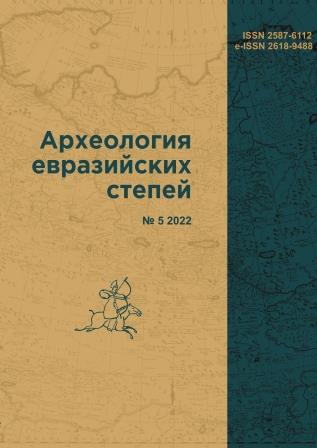The Settlement of Igimskiy Bor I is a New Site of the Seima-Turbino Chronological Horizoni (preliminary research results)
DOI:
https://doi.org/10.24852/2587-6112.2022.5.207.216Keywords:
archaeology, Kama river, Ik river, Kulegash lake-marsh massif, Seima-Turbino transcultural phenomenon, items made of metal, metalworking, emission spectral analysis.Abstract
The materials obtained from a newly found archaeological site – Igimskiy Bor I settlement are published in the paper. The settlement is located on the edge of the butte of a high terrace on the right bank of the Ik river oxbow, in a protected area of regional significance "Igimskiy Bor". During reconnaissance, at the first time, a copper knife was found with the distinctive features of the Seima-Turbino chronological horizon. A trial trench was made on this area, in its buried soil small pieces of ceramics, ceramic and metallurgical slags, drops of copper and animal bones were found. The spectral analysis of the knife and two metal drops revealed both their similarity – metallurgically pure copper, and differences in micro inclusions (the presence of silver and iron tempers in the composition of the knife metal in one-tenth of a percent). Judging by the analogies of the copper knife and pieces of ceramics, the time of the settlement's existence falls on the end of the Eneolithic – the beginning of the Late Bronze Age (the end of the III – beginning of the II thousand BC). Probably, the settlement of Igimskiy Bor I can be attributed to the number of poorly studied industrial workshops in this area.
References
Baranov, V. I. 1947. Bolota i torfyaniki Tatarii (Swamps and Peatlands of Tataria). Kazan: “Tatgosizdat” Publ. (in Russian).
Gabyashev, R. S., Starostin, P. N. Otchet Tatarskogo otryada Nizhnekamskoy arkheologicheskoy ekspeditsii (Report of the Tatar detachment of the Nizhnekamsk archaeological expedition team) 1. Archive of the Institute of Archaeology of the Russian Academy of Sciences, inv. R-1, dossier 4121 (in Russian).
Gabyashev, R. S., Starostin, P. N. 1972. Otchet o polevykh issledovaniyakh Tatarskogo otryada Nizhnekamskoy arkheologicheskoy ekspeditsii v 1971 g. (Report on Field Studies of the Tatar Group of Nizhnekamsk Archaeological Expedition in 1971) 1. Archive of the Institute of Archaeology of the Russian Academy of Sciences, inv. R-1, dossier 4601 (in Russian).
Denisov, V. P., Mel’nichuk, A. F., Treskov, S. A. 2012. In Belavin, A. M. (ed.). Trudy Kamskoi arkheologo-etnograficheskoi ekspeditsii (Proceedings of the Kama Archaeological and Ethnographical Expedition) VIII. Perm: Perm State Humanitarian Pedagogical University, 115–120 (in Russian).
Korochkova, O. N., Stefanov, V. I., Spiridonov, I. A. 2020. Svyatilishche pervykh metallurgov Srednego Urala (Sacred Place of the First Metallurgists in the Middle Ural). Ekaterinburg: Ural University Publ. (in Russian).
Kuzminykh, S. V. 2011. In Kratkie soobshcheniia Instituta arkheologii (Brief Communications of the Institute of Archaeology) 225, 240–263 (in Russian).
Lyganov, A. V., Morozov, V. V., Smirnov, A. L., Khramchenkova, R. Kh. 2022. In Povolzhskaya arkheologiya (Volga River Region Archaeology) 39 (1), 104–117. DOI 10.24852/pa2022.1.39.104.117 (in Russian).
Molodin, V. I., Epimakhov, A. V., Marchenko, Zh. V. 2014. In Vestnik Novosibirskogo Gosudarstvennogo universiteta. Istoriia, filologiya (Bulletin of the Novosibirsk State University: History, Philology) 13 (3), 136–167 (in Russian).
Morozov, V. V. 2020. In Arkheologiia evraziiskikh stepei (Archaeology of the Eurasian Steppes) 3, 330–353. DOI 10.24411/2587-6112-2020-1-0027 (in Russian).
Solov’ev, B. S. 2000. Bronzovyi vek Mariiskogo Povolzh’ia (Bronze Age of Mari Volga Area). Series: Proceedings of the Mari Archaeological Expedition VI. Yoshkar-Ola: Mari Research Institute of Language, Literature, and History (in Russian).
Solov’ev, B. S. 2013. In Povolzhskaya arkheologiya (Volga River Region Archaeology) (2), 18–39 (in Russian).
Solov’ev, B. S. 2016. Arkheologicheskie kul'tury iuga lesnogo Povolzh'ia na rubezhe srednego i pozdnego bronzovogo veka (Archaeological Cultures of the Southern Forest Volga Region at the Turn from the Middle to the Late Bronze Age). Yoshkar-Ola: Mari State University (in Russian).
Khalikov, A. Kh. 1959. Otchet o polevykh rabotakh arkheologicheskoy ekspeditsii IYaLI KFAN SSSR za 1958 god. (Report on the Fieldworks of the Archaeological Expedition of G. Ibragimov Language, Literature and History Institute, Kazan Branch of the USSR Academy of Sciences in 1958). Kazan. Archives of the Institute of Archaeology of the Russian Academy of Sciences. Inv. R-1, dossier 1771 (in Russian).
Chernykh, E. N. 1970. Drevneishaia metallurgiia Urala i Povolzh’ia (Ancient Metallurgy of Ural and Volga Region). Materialy i issledovaniia po arkheologii SSSR (Materials and Research in the USSR Archaeology) 172. Moscow: “Nauka” Publ. (in Russian).
Chernykh, E. N., Kuzminykh, S. V. 1989. Drevniaia metallurgiia Severnoi Evrazii (seiminsko-turbinskii fenomen) (Ancient Metallurgy of Northern Eurasia (Seyma-Turbino Phenomenon)). Moscow: “Nauka” Publ. (in Russian).

Downloads
Published
How to Cite
Issue
Section
License
Copyright (c) 2022 A.V. Lyganov, V.V. Morozov, A.L. Smirnov, R.KH. Khramchenkova

This work is licensed under a Creative Commons Attribution-NonCommercial 4.0 International License.







